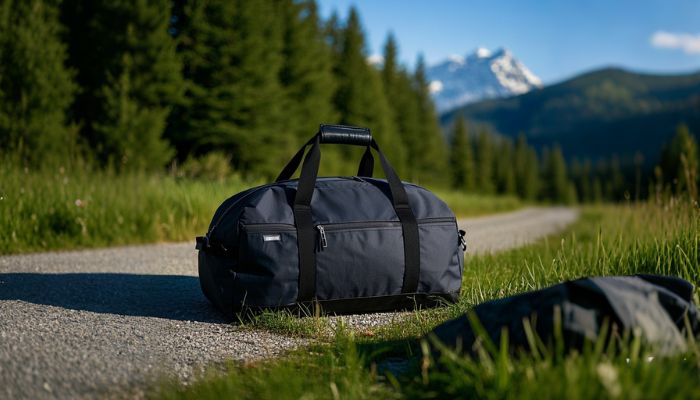
In the world of modern travel, a duffle bag has become an essential item. Whether you’re embarking on a short weekend getaway, a long-haul international adventure, hitting the gym, or traveling for business, a reliable duffle bag can make your journey much more convenient. However, with the vast array of options available in the market, ranging from different qualities to diverse functions, choosing the right one can be a daunting task. This comprehensive buying guide is designed to help you make an informed and intelligent decision.
1. Defining Your Usage Requirements
Type of Travel
Leisure Travel: If your trips mainly consist of vacations and sightseeing, you’ll need a bag that can comfortably hold your clothes, toiletries, camera, and other travel essentials. A stylish and casual design would be a plus, as it can complement your laid-back travel outfits. For example, a trip to a beach destination might require space for swimsuits, beach towels, and sunscreen, along with a couple of changes of clothing for evenings out.
Business Travel: Here, functionality and professionalism are key. Look for a duffle bag with dedicated compartments for your laptop, important documents, and office supplies. The exterior should have a sleek and sophisticated appearance, and the material should exude quality. A bag with a padded laptop sleeve and organizational pockets for pens, notebooks, and business cards would be ideal for those frequent business trips.
Outdoor Adventures: Durability, water resistance, and a reliable carrying system are non-negotiable for outdoor enthusiasts. You’ll need ample space to store camping gear like tents, sleeping bags, cooking utensils, and hiking tools. The bag should be able to withstand rough terrains, extreme weather conditions, and the rigors of being tossed around in the back of a vehicle or carried on your back for long distances.
Fitness Use: A fitness-focused duffle bag should feature a separate wet and dry compartment. This allows you to store your sweaty workout clothes and shoes away from your clean items. Additionally, it would be beneficial if it had provisions for carrying fitness accessories such as yoga mats, resistance bands, or small dumbbells. Some bags even come with specialized pockets for water bottles and protein shakers.
Duration of Travel
Short Trips (1 – 3 Days): A compact 20L – 30L duffle bag is usually sufficient. You can pack a few changes of underwear, a couple of tops and bottoms, toiletries, and perhaps a tablet or e-reader. This size is perfect for a quick city break or a short business trip where you don’t need to carry a lot of items.
Medium Trips (3 – 7 Days): A 30L – 50L bag offers more room for additional clothing, a pair of shoes, a book or two, and some small souvenirs. It’s great for a week-long vacation where you might need a bit more variety in your wardrobe or want to bring along some entertainment for those downtime moments.
Long Trips (7 Days or More): For extended travels, a 50L or larger capacity duffle bag is essential. You’ll need space for multiple pairs of shoes, a week’s worth of clothing, electronic devices like laptops and chargers, and any other personal items you can’t live without. This size is also suitable for backpacking trips where you’ll be on the move for an extended period and need to carry all your necessities.
Preferred Carrying Method
Hand-carrying: Ideal for short distances and urban exploration. The handle of the duffle bag should be comfortable to grip and sturdy enough to support the weight of the bag when full. A padded handle or one with an ergonomic design can prevent hand fatigue. Also, make sure the overall weight of the bag is manageable, as you’ll be carrying it in your hand most of the time.
Shoulder-carrying: If you anticipate carrying the bag for long periods, the shoulder strap design is crucial. Look for wide, padded straps that can distribute the weight evenly across your shoulder. Adjustable straps are a must, allowing you to customize the fit according to your body size and comfort. Additionally, a breathable back panel or shoulder strap lining can help reduce sweating and discomfort during extended wear.
Trolley-Style: For larger duffle bags with wheels, the quality of the wheels and the telescopic handle matters. The wheels should be smooth-rolling, quiet, and durable, capable of handling different terrains like airport floors, sidewalks, and even rough pavements. The telescopic handle should be strong and adjustable to different heights, ensuring a comfortable pulling experience.
2. Material Considerations
Common Material Characteristics
Nylon: This material is a popular choice due to its numerous advantages. It is highly resistant to wear and tear, making it suitable for the rough and tumble of travel. Its lightweight nature means it won’t add unnecessary bulk to your luggage. Nylon is also waterproof, protecting your belongings from unexpected rain showers or spills. It is relatively affordable compared to some other materials, making it accessible to a wide range of budgets. You can find nylon duffle bags in various colors and styles, suitable for different travel occasions.
Canvas: Canvas has a classic and durable charm. It is known for its sturdiness and can withstand heavy use over time. The fabric has a unique texture that gives a rustic or vintage feel to the bag, which is popular among those who appreciate a more traditional look. However, canvas is heavier than nylon, so it might not be the best choice if you need to carry the bag for long distances. It does have good breathability, which can be beneficial for items that might generate moisture, like sweaty clothes or damp towels.
Leather: Leather duffle bags are synonymous with luxury and style. They have a high-end appearance that can enhance your overall travel ensemble, especially for business or formal trips. Leather is durable and ages gracefully, developing a patina over time. However, it is the heaviest of the common materials and requires regular maintenance to keep it in good condition. This includes cleaning, conditioning, and protecting it from water and sunlight. Leather bags also tend to be more expensive due to the cost of the material and the craftsmanship involved.
Special Material Properties
Waterproof Coated Materials: These are created by applying a waterproof coating to a base material like nylon or canvas. The coating forms a protective barrier that repels water, ensuring your belongings stay dry even in wet conditions. However, over time and with regular use, the coating can wear off, reducing the bag’s waterproof effectiveness. Some manufacturers offer re-treatment options or recommend specific products to maintain the waterproofing.
Tear-Resistant Materials: Constructed with special weaving techniques or reinforced with additional fibers, these materials are designed to withstand the stress of being caught on sharp objects or being pulled in different directions. They are a great investment for outdoor activities where your bag might come into contact with rough surfaces, branches, or rocks. A tear-resistant duffle bag can save you from the inconvenience of a damaged bag and lost belongings in the middle of a trip.
Impact of Material on Weight and Capacity
Weight: Lighter materials like nylon are perfect for those who need to keep their luggage weight in check. A lighter bag is easier to carry, whether it’s by hand, over the shoulder, or on your back. On the other hand, leather, while adding a touch of elegance, can significantly increase the overall weight of the bag. When choosing a material, consider how much you’ll be carrying in the bag and whether the added weight of a particular material is worth the style or durability it offers.
Capacity: The thickness and flexibility of the material can affect how much you can fit inside the duffle bag. Thinner and more pliable materials like nylon can conform to the shape of your belongings, allowing you to make the most of the available space. In contrast, thicker or stiffer materials might leave some empty gaps, reducing the effective capacity. For example, a nylon duffle bag might be able to hold an extra sweater or a pair of shoes compared to a similarly sized leather bag due to its ability to compress and expand around the items.
3. Size Selection Essentials
The importance of selecting the right size cannot be overstated. A bag that is too large will be cumbersome to carry and might even lead to overpacking, resulting in additional baggage fees for flights. Conversely, a bag that is too small will leave you struggling to fit all your necessities.
20L – 30L: Ideal for short trips, this size can hold a few days’ worth of clothing, basic toiletries, and a small electronic device. For instance, it can easily accommodate two or three changes of clothes, a toiletry bag, a phone charger, and a book. It’s perfect for a weekend trip to visit friends or a short business trip where you don’t need a lot of extras.
30L – 50L: This mid-sized range is great for trips lasting 3 – 7 days. You can pack more clothing options, including a couple of pairs of shoes, a few extra toiletries, and some entertainment items like a tablet or a small camera. It’s suitable for a week-long vacation where you might want to have different outfits for different activities or a business trip with a few extra days of leisure.
50L – 70L: For longer vacations or trips where you need to carry more equipment, such as for outdoor adventures or extended business trips with multiple stops, a 50L – 70L duffle bag is a better choice. You can fit several pairs of shoes, a week’s worth of clothing, a laptop and its accessories, and even some camping or sports gear if needed.
70L and Above These large-capacity bags are designed for long-term travel, backpacking trips, or when you need to carry a significant amount of gear. They can hold a large quantity of clothing, multiple pairs of shoes, bulky items like sleeping bags and tents, and all the other essentials for an extended journey.
If you’re planning to travel by air, it’s crucial to be aware of the airline’s baggage restrictions. Different airlines have specific size and weight limits for both checked and carry-on luggage. Make sure the duffle bag you choose complies with these regulations to avoid any last-minute hassles at the airport.
4. Functional Design Analysis
Internal Structure
Compartment Design: Multiple compartments inside the duffle bag can make a world of difference in keeping your items organized. A dedicated laptop compartment with padding protects your computer from bumps and scratches. Separate compartments for underwear, socks, and other clothing items prevent them from getting mixed up. A shoe compartment, often with a breathable lining, keeps your shoes separate from your clean clothes and helps maintain the overall cleanliness of the bag.
Pocket Arrangements: Interior pockets are great for storing small items like keys, wallets, passports, and headphones. They keep these essentials easily accessible and prevent them from getting lost in the main compartment. Exterior pockets, on the other hand, are convenient for quickly grabbing frequently used items. For example, a front pocket can hold your phone, boarding pass, or a small water bottle, allowing you to access them without having to open the entire bag.
Compression Features: Some duffle bags come with compression straps or areas. These are especially useful when packing bulky items like winter coats or multiple layers of clothing. By tightening the compression straps, you can reduce the volume of the items and create more space in the bag. This is also handy if you need to fit in a few last-minute purchases during your trip.
External Characteristics
Handle Design: The handle of a duffle bag should be both strong and comfortable. A well-designed handle has a good grip, preventing it from slipping out of your hand. It should also be able to support the weight of the fully loaded bag without breaking or deforming. Some handles are adjustable in length, which can be convenient depending on your height and carrying style.
Shoulder Strap Innovations: In addition to the basic requirements of wide, padded, and adjustable shoulder straps, some additional features can enhance the usability of the bag. Hidden shoulder straps are a great option for bags that can be carried in multiple ways. When you don’t need to use the shoulder straps, you can tuck them away, giving the bag a more streamlined appearance. Convertible shoulder straps that can transform the duffle bag into a backpack-style carrier are also popular. This allows you to distribute the weight more evenly across your back and shoulders, especially when carrying heavier loads for longer periods.
Attachment Points: For outdoor enthusiasts, attachment points on the outside of the bag are essential. These can be used to secure items like tents, sleeping pads, or climbing ropes. They expand the carrying capacity of the bag and make it easier to transport bulky gear. Some bags have loops, hooks, or daisy chains for attaching additional accessories or equipment.
Waterproof Cover: Even if a duffle bag has some level of water resistance, a built-in or detachable waterproof cover can provide an extra layer of protection. In case of heavy rain or wet conditions, you can pull out the cover and ensure that your belongings stay completely dry. This is especially important for trips where you might be exposed to unpredictable weather or if you’re traveling to a place with a high chance of rain.
Smart Functions
Charging Capabilities: With the increasing reliance on electronic devices during travel, a duffle bag with a built-in USB charging port or wireless charging function can be a real convenience. However, it’s important to consider the battery capacity of the built-in power source and the charging speed. Some bags might only provide a slow charge, which might not be sufficient for quickly charging your phone or tablet. Also, make sure the charging function is compatible with your devices.
Location Tracking: High-end duffle bags now come equipped with Bluetooth or GPS tracking technology. This allows you to use a smartphone app to track the location of your bag. It’s a great feature for preventing loss or theft, especially in crowded airports, train stations, or hotels. However, keep in mind that these tracking features can consume battery power, and you might need to recharge the bag’s battery regularly. Also, there may be a subscription fee associated with using the tracking service.
5. Purchase Channels and After-Sales Service
Buying Avenues
Physical Stores: Visiting a brick-and-mortar store allows you to physically examine the duffle bag. You can feel the material, check the stitching, test the zippers, and assess the overall build quality. You can also try carrying the bag in different ways to see how it feels on your body. However, the selection in physical stores might be limited compared to online platforms, and the prices may be higher due to overhead costs. Examples of physical stores include large department stores with a luggage section, specialty outdoor gear shops, and dedicated luggage boutiques.
Online Shopping Platforms: Platforms like Taobao, JD.com, and Amazon offer a vast array of duffle bags from different brands and at various price points. You can easily compare prices, read customer reviews, and view detailed product descriptions and images. However, the downside is that you can’t physically touch or feel the product before purchasing. There is also a risk of receiving a product that doesn’t meet your expectations. To mitigate this risk, make sure to choose a reputable seller with a high rating and positive feedback. Also, carefully read the return and exchange policies before making a purchase.
Brand Official Websites: Buying directly from the brand’s official website ensures that you’re getting an authentic product. Some brands offer exclusive deals or new product launches on their websites. However, the prices may not be as competitive as those on larger online marketplaces, and there may be fewer discounts available.
After-Sales Support
It’s important to understand the after-sales service provided by the brand or seller. Look for a warranty period that covers manufacturing defects. A good return and exchange policy allows you to return or exchange the bag if it doesn’t meet your needs or if there is a problem with the product. Some brands also offer repair services, which can be useful if your bag gets damaged during normal use. Knowing that you have reliable after-sales support gives you peace of mind and protects your investment.
6. User Reviews and Reputation References
Before making a purchase, it’s essential to read user reviews. These reviews can provide valuable insights into the real-world performance of the duffle bag.
Importance of User Feedback: User reviews can tell you about the durability of the material. For example, if multiple reviewers mention that the fabric started to fray after a few uses, it’s a red flag. They can also highlight the functionality of the bag. If users complain that the compartments are too small or the pockets are poorly designed, it might not be the right bag for you. Comfort is another aspect that can be gauged from reviews. If people report that the shoulder straps are uncomfortable or the handle digs into their hands, you’ll know to look for a different option.
Finding Authentic Reviews: On shopping platforms, look for reviews with detailed descriptions and photos or videos. A large number of reviews also adds credibility. Check multiple platforms and sources, including travel forums and social media groups dedicated to travel gear. For example, on a travel forum, you might find in-depth discussions about a particular brand of duffle bag, including both positive and negative experiences. Social media platforms like Instagram or Facebook can also have user groups or pages, where people share their travel gear, finds, and experiences.
Let’s take an example. One brand of duffle bag received numerous negative reviews because the zippers kept breaking. On the other hand, another brand was highly praised for its excellent waterproofing and well-thought-out internal organization. These examples show how user reviews can help you make a more informed decision.
7. Summary and Recommendations
In summary, when buying a duffle bag, there are several key factors to consider. Your usage requirements, including the type of travel, duration of travel, and preferred carrying method, will determine the basic features you need. The material of the bag affects its durability, weight, and appearance. Size selection is crucial to ensure you have enough space for your belongings without overpacking or being left with too little room. The functional design, both internal and external, as well as any smart features, can enhance the convenience and usability of the bag. The purchase channel you choose impacts the price, selection, and risk of getting a subpar product. And finally, user reviews and after-sales service provide valuable information about the bag’s performance and the brand’s reliability.
Before making a purchase, take the time to clearly define your travel plans and your specific needs for a duffle bag. Then, carefully evaluate and compare different options based on the abovementioned factors. Don’t rush into a decision; a well-chosen duffle bag can be a long-term travel companion.
After you’ve purchased and used the bag on your travels, we encourage you to share your experience. Your feedback can help other travelers make more informed decisions and contribute to a community of well-informed consumers. Happy travel



